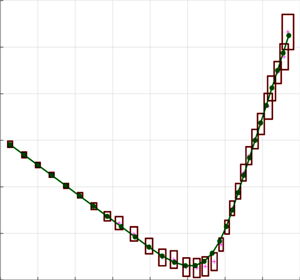Adaptive algorithm of maneuvering target tracking in complex jamming situation for multifunctional radar with phased antenna array
DOI:
https://doi.org/10.3103/S0735272719070021Keywords:
multifunctional radar station, phased antenna array, maneuvering target, Markov process, optimal algorithm, quasioptimal algorithmAbstract
Adaptive multimodel algorithms based on the target movement model in the form of discrete stochastic dynamic system with random structure are adequate to the problem of target tracking based on data of the multifunctional radar station (MFRS) with phased antenna array (PAA) under conditions of complex dynamically varying signal and jamming situation. This study presents an optimal and quasioptimal algorithms of adaptive estimation of movement parameters of maneuvering targets in the Cartesian coordinate system for MFRS with PAA based on the mathematical tools of mixed Markov processes in discrete time. They describe the evolution of joint a posteriori probability density of the vector of target movement parameters and switching variable determining the mode of its movement, while the filters implementing them are referred to the class of devices with feedbacks between channels. The identification of blips in the tracking strobe is performed in the spherical coordinate system by selecting the blip, which is the closest to the strobe center. The efficiency analysis of the developed tracking algorithm is performed by using the test paths of two targets with different intensities of the maneuver and parameters of tracking modes. The accuracy characteristics of adaptive filter and indicators of the tracking efficiency at different false alarm probabilities have been determined.References
- VERBA, V.S. Air Radar Surveillance and Guidance Complexes. The State of Art and Development Trends [in Russian]. Moscow: Radiotekhnika, 2008.
- GOUZ, V.I.; LIPATOV, V.P.; BARINGOLTS, T.V.; BILOKOZ, S.S.; SMERTENKO, E.V.; SUBBOTINA, L.B.; TORHONSKYY, V.V. “Design concepts of complex information processing systems with data from many different-type sources located at one or several mobile platforms,” Radioelectron. Commun. Syst., v.55, n.1, p.1, 2012. DOI: https://doi.org/10.3103/S0735272712010013.
- BALININ, M.; DALANDIN, A. “State of the art and development prospects of ground distant early warning radars,” Zarubezhnoye Voyennoye Obozreniye, n.1, p.69, 2016.
- GOUZ, V.I.; BUTYRIN, A.V.; LIPATOV, V.P.; BARINGOLTS, T.V. “Adaptive control of distribution of the energy and time resource of radar systems with phased antenna array,” Radioelectron. Commun. Syst., v.50, n.2, p.55, 2007. DOI: https://doi.org/10.3103/S073527270702001X.
- SCHIKORR, M.; FUCHS, U.; BOCKMAIR, M. “Radar resource management study for multifunction phased array radar,” Proc. of 2016 European Radar Conf., EuRAD, 5-7 Oct. 2016, London, UK. IEEE, 2016, p.213-216. URI: https://ieeexplore.ieee.org/document/7811685.
- ZHANG, H.-W.; XIE, J.-W.; LU, W.-L.; SHENG, C.; ZONG, B.-F. “A scheduling method based on a hybrid genetic particle swarm algorithm for multifunction phased array radar,” Frontiers Inf. Technol. Electronic Engineering, v.18, n.11, p.1806, 2017. DOI: https://doi.org/10.1631/fitee.1601358.
- ALAHMADI, M.S.; SMITH, G.E.; BAKER, C.J. “A recursive approach for adaptive parameters selection in a multifunction radar,” Proc. of 2016 IEEE Radar Conf., RadarConf, 2-6 May 2016, Philadelphia, USA. IEEE, 2016. DOI: https://doi.org/10.1109/radar.2016.7485148.
- SMIRNOV, O.L.; STAVITSKIY, O.N.; NAKONECHNYI, A.A. “Adaptive control of tracking mode parameters of a multi-function radar,” Science and Technologies of Air Forces of Armed Forces of Ukraine, n.1, p.71, 2017. DOI: https://doi.org/10.30748/nitps.2017.26.15.
- KONOVALOV, A.A. Essentials of Trajectory Processing of Radar Information, Part 2 [in Russian]. St. Petersburg: LETI, 2014.
- LI, X. Rong; JILKOV, V.P. “Survey of maneuvering target tracking. Part V. Multiple-model methods,” IEEE Trans. Aerospace Electron. Syst., v.41, n.4, p.1255, 2005. DOI: https://doi.org/10.1109/TAES.2005.1561886.
- BARTON, D.K. Radar System Analysis and Modelling. Norwood, MA: Artech House, Inc., 2005.
- GOUZ, V.I.; BUTYRIN, A.V.; BARINGOLTS, T.V.; SUBBOTINA, L.B. “Peculiarities of airway processing when tracking air targets observed at small elevation over underlying surface,” Radioelectron. Commun. Syst., v.50, n.1, p.9, 2007. DOI: https://doi.org/10.3103/S0735272707010025.
- BAR-SHALOM, Y.; LI, Xiao-Rong. Estimation and Tracking: Principles, Techniques, and Software. YBS Pub., 1998.
- BLACKMAN, S.; POPOLI, R. Design and Analysis of Modern Tracking Systems. Boston: Artech House, 1999.
- ZHUK, S.Ya. “Joint filtering of mixed Markov processes in discrete time,” Radioelectron. Commun. Syst., v.31, n.1, p.29, 1988. URI: http://radioelektronika.org/article/view/S073527271988010066.
- KUZ’MIN, S.Z. Digital Radiolocation. Introduction to the Theory [in Russian]. Kyiv: KViTs, 2000.
- FARINA, A.; STUDER, F.A. Radar Data Processing. Vol. I: Introduction and Tracking. Wiley, 1985.
- YOU, H.; JIANJUAN, X.; XIN, G. Radar Data Processing with Applications. John Wiley & Sons Singapore Pte. Ltd., 2016. DOI: http://doi.org/10.1002/9781118956878.
- MERKULOV, V.I.; VERBA, V.S.; IL’CHUK, A.R.; KIRSANOV, A.P. Automatic Target Tracking in Radars of Integrated Air Complexes. Multitarget Tracking, Part 3 [in Russian]. Moscow: Radiotekhnika, 2018.
- ZHUK, S.Ya.; TOVKACH, I.O.; REUTSKA, Yu.Yu. “Adaptive filtration of radio source movement parameters based on sensor network TDOA measurements in presence of anomalous measurements,” Radioelectron. Commun. Syst., v.62, n.2, p.61, 2019. DOI: https://doi.org/10.3103/S073527271902002X.

Downloads
Published
2019-07-25
Issue
Section
Research Articles

